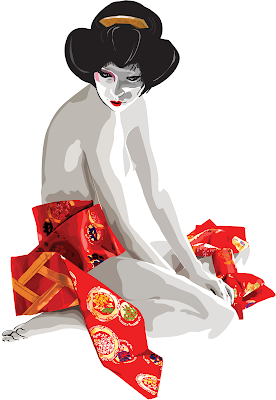
First off vector images are great in a number of ways, but their real advantage from a designer or artist's point of view is their scalability. You can make them reeeeally really big or really small with no loss of clarity whatsoever. You won't be able to test that here, because once I have posted an image to the web, it becomes a raster image, meaning it's made up of a bunch of little pixels. Everything you see online is a raster image no matter what program it was created in, no matter what file format it was saved in. Got that? That was vexation number one.
Vectors only really have an advantage in print media. If you think about a logo for instance that might get printed on everything from a business card to a box car then you will be able to appreciate the importance of scalability and why logos are almost always vector images. But this wasn't about logos or print even. These were for things supposedly meant for the web. So not being able to achieve the effect that I wanted for some small online icons with vectors, or in this case in Illustrator in general, I got in a snit about the whole "must be vector" regime that I was dealing with at the time.
I got over it more or less, but then there was the whole separate issue of the vexel, which is different than a vector image. A vexel is a sort of bastardization of vector based images and pixel based images. They start out in Photoshop, a program that I love dearly despite its inability to create real vectors. What I think happened was that people who had Photoshop, but lacked Illustrator learned to use the former's ability to make vectorish shape layers as a means to achieve an almost vector image. Sorry for the jargon, if you're not a user of these things yourself.
Bizarrely enough however, what they chose to do with these almost vector images was to trace photographs which had first been manipulated in Photoshop. The manipulations are aimed specifically at achieving clearly defined areas of subtle color changes, which can then be traced using the pen tool and filled in with solid colors to mimic a vector shape. Many such shapes on many layers make a picture called a vexel. If you have ever seen a paint by numbers kit, then you'll have some idea what I am talking about. The plan goes something like this. Find a very detailed high resolution image and blur it in Photoshop, then posterize it into bands of color, then apply a blur layer to restore its original colors. Then faithfully, slavishly trace each and every one of the shapes you can see on a separate layer and viola, you get an image that is virtually indistinguishable from its posterized form. The main difference is that getting there in Photoshop doing nothing other than applying filters and adjustments takes 3-5 minutes, and getting from there to the finished traced version is likely to take 3-5 days. See the added aesthetic value? I don't.
In case the above isn't quite masochistically tedious enough, people doing this in Photoshop are forced to use the pen tool, since it is the only way to freehand a psuedo vector shape layer. Now the pen tool has a lot going for it if you need straight lines or bezier curves. But last time I had a good long look at a portrait or a landscape, both of these were in short supply. The world of natural things is kinda lumpy and rough around the edges. So the pen tool, which is touchy and time consuming is not the tool you want unless you need a perfectly smooth curve or a perfectly straight line.
Lucky for us, we did not have to do our completed vexel in Photoshop, we got to move over to Illustrator, which specializes in vector images and so has lots and lots of tools for tracing and drawing, all of which will produce vector shapes by default. Alas most people still stuck slavishly to the pen tool, because the instructions said to. Make that that 3-5 days above into 3-5 weeks and you'll get an idea of how many student hours went into making these things.
If you search the word vexel you will find lots, as well as tutorials if you have time on your hands and want to make your own. Most are much more photo-realistic than mine above. And my friend Dano has made a couple of gorgeous ones, one of which you can see here.
Actually, once I finally got off my ass and started one, I came to see the number of hours required as part of their charm. It is a lot like doing needlepoint, which I confess I used to find sort of addictive. If you combine vexel tracing with a decent podcast or two, you can pretty much do this until the cows come home, and if you're like me and don't have any cows, you can pretty much do this forever. Plus, when you're finally finished the damn thing, you don't need to sew it into a pillow. You can print it on the side of a box car and watch its perfectly sharp lines and flat colors fade off into the distance.



No comments:
Post a Comment